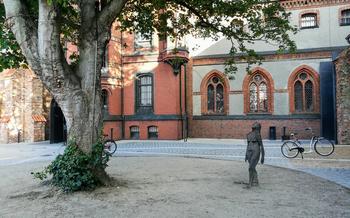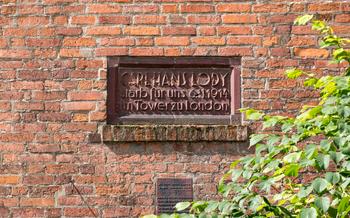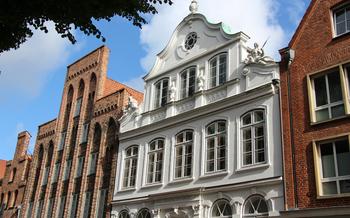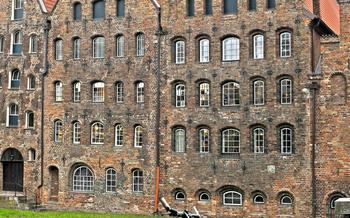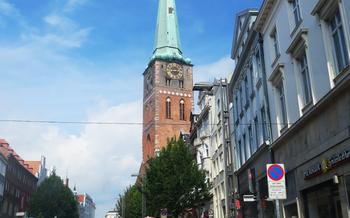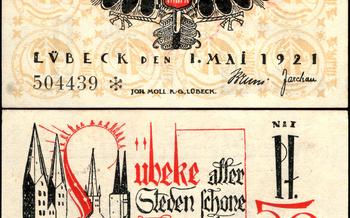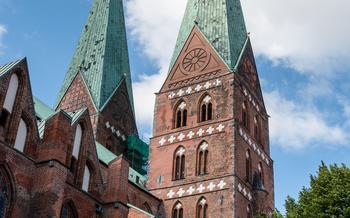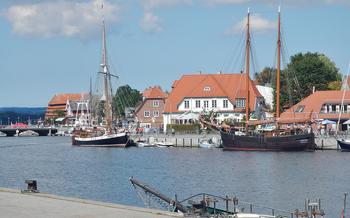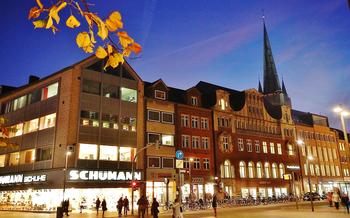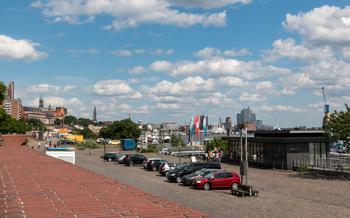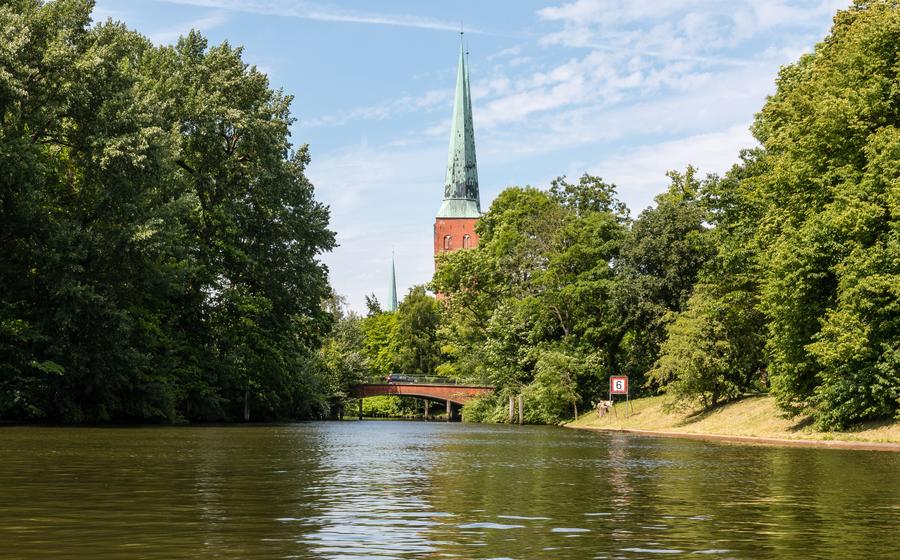
Lübecker Dom (Lübeck Cathedral)
- Lübecker Dom (Lübeck Cathedral), a Historical Marvel:
- Exploring the Interior
- Triumphal Cross, a Masterpiece of Art
- Totentanz, a Dance with Death
- Climbing the Tower for Panoramic Views
- Attending a Service or Concert
- Exploring the Surroundings
- Lübecker Marzipan, a Sweet Treat
- Photography Opportunities
- Accessibility for Visitors with Disabilities:
- Guided Tours and Audio Guides
- Respecting Religious Practices:
- Insider Tip: Mysterious Crypt
Lübecker Dom (Lübeck Cathedral), a Historical Marvel:
Lübeck Cathedral, a majestic edifice nestled in the heart of Lübeck, Germany, stands as a testament to the city's rich history and cultural heritage. This Gothic masterpiece, constructed between 1173 and 1335, has witnessed centuries of religious devotion, artistic expression, and historical events. As the mother church of the former Prince-Bishopric of Lübeck, the cathedral served as a spiritual and administrative center, leaving an indelible mark on the city's identity. Today, it remains an active place of worship and a popular tourist destination, attracting visitors from around the globe with its stunning architecture, awe-inspiring artworks, and profound religious significance. The cathedral's unique blend of Romanesque and Gothic elements, its intricate carvings, and its towering spires make it an architectural marvel that continues to captivate and inspire.
Exploring the Interior
The interior of the Lübecker Dom is a testament to the grandeur of Gothic architecture. As you step inside, you will be awestruck by the soaring vaulted ceilings, which create a sense of awe and reverence. The cathedral's impressive stained glass windows, depicting biblical scenes and historical figures, bathe the interior in a kaleidoscope of colors.
One of the most notable artworks in the cathedral is the Triumphal Cross, a 17-meter-high crucifix that dominates the central nave. Created in the 15th century, the cross is a masterpiece of medieval craftsmanship, showcasing intricate carvings and symbolism. It serves as a poignant reminder of the crucifixion of Jesus Christ and the central role of faith in the cathedral's history.
Another highlight of the interior is the Totentanz, or Dance of Death, a series of murals depicting the allegorical theme of death. Painted in the 15th century, the murals feature skeletons leading people from all walks of life, including kings, popes, and peasants, in a macabre dance towards their inevitable demise. The Totentanz serves as a powerful reminder of the transience of life and the inevitability of death, regardless of one's social status or wealth.
To gain a deeper understanding of the cathedral's history and significance, guided tours are available in various languages. These tours offer insights into the architectural features, religious symbolism, and historical events that have shaped the cathedral over the centuries. Audio guides are also available for self-guided exploration, providing detailed commentary on the cathedral's highlights.
Triumphal Cross, a Masterpiece of Art
Description: The Triumphal Cross, a monumental crucifix that towers 17 meters high within the Lübeck Cathedral, is a masterpiece of medieval craftsmanship. The cross features a life-sized corpus of Jesus Christ, meticulously carved from a single piece of oak wood. The intricate details and expressive agony captured in the figure's face and body evoke a profound sense of reverence.
Symbolism: The Triumphal Cross is not merely an artistic marvel but also a powerful symbol of Christian faith. The cross represents the victory of Christ over death and sin, embodying the core message of salvation. The intricate carvings adorning the cross, such as the lamb symbolizing Christ's sacrifice, reinforce its profound religious significance.
Historical Context: The Triumphal Cross was commissioned in the 15th century by Bishop Johannes Schele, who envisioned a grand centerpiece for the newly built cathedral. The cross was crafted by an unknown artist, likely from the Lübeck region, who poured their heart and soul into creating this masterpiece.
Practical Information: To fully appreciate the Triumphal Cross, visitors can take a closer look from the designated viewing platform. The cross is illuminated during certain hours, allowing visitors to admire its intricate details even in low-light conditions. Guided tours often include an in-depth explanation of the cross's symbolism and historical significance.
Totentanz, a Dance with Death
Lübecker Dom's most captivating feature is the Totentanz, a series of 15th-century murals known as the Dance of Death. These striking paintings depict a macabre procession of people from all walks of life, from popes and emperors to peasants and beggars, being led to their graves by the Grim Reaper.
The Totentanz is a powerful reminder of the universality of death and the futility of earthly possessions. The murals were created during the Black Death, a devastating plague that wiped out nearly half of Europe's population. The vivid imagery of the Totentanz reflects the profound fear and uncertainty that gripped people during this tumultuous time.
Each mural depicts a different social class or profession, from the pope to the beggar, dancing with a skeleton representing Death. The skeletons are depicted as relentless and merciless, leading their victims to the grave regardless of their status or wealth. The paintings are a stark reminder that death is the great equalizer, and that no one is immune to its grasp.
The Totentanz is a unique and valuable work of art that offers a glimpse into the medieval mind. It is a powerful reminder of the fragility of life and the importance of living each day to the fullest.
Practical Information:
- Location: The Totentanz murals are located in the north aisle of Lübecker Dom.
- Viewing: The murals are accessible during the cathedral's opening hours.
- Guided Tours: Guided tours of the Totentanz are available and provide insights into the history and symbolism of the murals.
Climbing the Tower for Panoramic Views
Ascending the 202 steps to the top of the Lübecker Dom's tower is an exhilarating experience that rewards visitors with breathtaking panoramic views of Lübeck and its surroundings. The tower, which stands at 70 meters tall, offers a unique perspective of the city's skyline, with its red-tiled roofs, spires, and the River Trave meandering through the landscape.
On a clear day, the views extend far beyond the city limits, allowing visitors to see as far as the Baltic Sea and the Holsteinische Schweiz region. The climb to the top is well worth the effort, as it provides a sense of accomplishment and a deeper appreciation for the cathedral's grandeur and its place within the city.
Throughout history, the tower has served as a lookout point, allowing guards to keep watch over the city and the surrounding countryside. Today, it continues to serve as a symbol of Lübeck's rich history and its enduring presence as a beacon of faith and community.
Practical Information:
-
Hours: The tower is open for climbing from April to October, with varying hours depending on the season. Check the cathedral's website for specific times.
-
Cost: There is a small fee for climbing the tower, which helps with the maintenance and preservation of the cathedral.
-
Accessibility: The climb to the top of the tower involves narrow stairs and is not suitable for individuals with limited mobility or claustrophobia.
Attending a Service or Concert
Lübecker Dom offers a unique opportunity to experience the spiritual and cultural heritage of Lübeck through its religious services and concerts. Regular masses are held throughout the week, allowing visitors to immerse themselves in the sacred atmosphere of the cathedral. Special events, such as Christmas Eve services or organ concerts, are also held throughout the year, offering a chance to witness the cathedral's acoustics and musical tradition firsthand.
Attending a service at Lübecker Dom is a deeply moving experience. The soaring architecture, intricate artwork, and melodious music create a sense of awe and reverence. Visitors can join the local congregation in prayer, listen to inspiring sermons, and experience the rich liturgical traditions of the cathedral.
Lübecker Dom's acoustics are renowned, making it a popular venue for concerts and musical performances. The cathedral's spacious interior and reverberant sound create an immersive experience for both performers and audience members. From classical concerts to contemporary music, the cathedral's diverse musical offerings cater to a wide range of tastes.
For those seeking a truly unforgettable experience, attending a concert or event at Lübecker Dom is highly recommended. Whether you're a religious pilgrim, a music enthusiast, or simply seeking a moment of spiritual reflection, the cathedral offers a transformative experience that will leave a lasting impression.
Practical Information: - Mass times and special events can be found on the cathedral's website. - Tickets for concerts and events can be purchased online or at the cathedral's box office. - Dress code is generally smart casual, but modest attire is recommended. - Visitors are encouraged to arrive early for services or concerts to secure a seat.
Exploring the Surroundings
Lübecker Dom stands as a beacon within the historic heart of Lübeck, a city steeped in Hanseatic heritage. Stepping out of the cathedral's hallowed halls, visitors find themselves immersed in a tapestry of architectural wonders, each narrating the city's rich past.
A short stroll leads to the Marienkirche, another Gothic masterpiece renowned for its towering spires and intricate brickwork. Just a few steps further, the Rathaus, with its opulent Renaissance facade, beckons visitors to explore the seat of Lübeck's former city government.
For those seeking a glimpse into the life and times of Lübeck's most famous literary family, the Buddenbrookhaus awaits. This former home of the Mann family, immortalized in Thomas Mann's novel "Buddenbrooks," offers a fascinating journey through the lives and works of these literary giants.
To fully immerse oneself in the city's captivating history, guided tours or leisurely walks through the cobbled streets are highly recommended. Discover hidden courtyards, uncover forgotten tales, and marvel at the architectural wonders that line Lübeck's enchanting streets.
Lübecker Marzipan, a Sweet Treat
Indulge your taste buds with the delectable flavors of Lübeck's culinary treasure, the world-famous marzipan. This sweet treat, made from almonds, sugar, and rose water, has been a cherished part of Lübeck's culinary heritage for centuries. Stroll through the enchanting streets of the city center and discover a myriad of confectionery shops and cafés dedicated to the art of marzipan making.
Unleash your inner child as you marvel at the intricate marzipan sculptures, each a testament to the artisans' skill and creativity. From lifelike animals and whimsical characters to miniature replicas of Lübeck's landmarks, the marzipan creations are a feast for the eyes and the palate. Indulge in a taste of heaven with a freshly baked marzipan croissant or a slice of marzipan cake, letting the sweetness melt in your mouth.
For a truly immersive experience, visit the Niederegger Marzipan Museum, a haven for marzipan enthusiasts. Immerse yourself in the history and production of this delectable treat, from its origins in the Middle East to its rise to prominence in Lübeck. Learn about the intricate process of marzipan making and admire the impressive collection of marzipan sculptures.
Whether you're a marzipan aficionado or simply seeking a sweet souvenir, Lübeck is the ultimate destination to satisfy your cravings. Don't miss the chance to savor the exquisite flavors of Lübecker marzipan, a true testament to the city's rich culinary legacy.
Photography Opportunities
The Lübecker Dom offers ample opportunities for photography enthusiasts to capture stunning images of its architectural marvel. The intricate details of the exterior, from the spires to the buttresses, provide a picturesque subject for photographers of all skill levels. Step inside the cathedral, and you'll be greeted by soaring vaulted ceilings, stained glass windows casting colorful hues, and awe-inspiring works of art. To capture the grandeur of the interior, consider using a wide-angle lens to fit in the expansive space.
For the best lighting conditions, plan your visit during the golden hours of sunrise or sunset. The warm glow of the setting sun casts a magical light on the cathedral's facade, creating a dramatic and ethereal atmosphere. If you're keen on capturing the intricate details of the interior, opt for a tripod to ensure sharp and steady shots.
While photography is generally permitted inside the cathedral, it's essential to be mindful of ongoing religious services or events. Please be respectful and avoid using flash or causing any disruption to worshippers or visitors. To ensure the best photography experience, consider joining a guided tour or obtaining permission from the cathedral staff for specific photography requests.
Accessibility for Visitors with Disabilities:
Lübecker Dom is committed to ensuring that all visitors have a welcoming and accessible experience. Wheelchair users and individuals with limited mobility can easily navigate the cathedral's interior through designated ramps and elevators. Accessible restrooms are also available for convenience. For those with visual or hearing impairments, special considerations have been made to enhance their visit. Guided tours with sign language interpretation can be arranged upon request, and audio guides are available with detailed descriptions of the cathedral's history and features. By providing these accessibility features, Lübecker Dom strives to create an inclusive environment where everyone can fully appreciate the cathedral's architectural and spiritual significance.
Guided Tours and Audio Guides
Lübecker Dom offers a variety of guided tours that provide a deeper understanding of its history, architecture, and religious significance. These tours are led by knowledgeable guides who share fascinating stories and insights about the cathedral.
Guided tours are available in different languages, including English, German, and Spanish, and typically last for about an hour. Visitors can choose from a variety of tour options, including general overviews, themed tours focusing on specific aspects of the cathedral, and even behind-the-scenes tours that explore hidden areas not usually accessible to the public.
For those who prefer a self-guided experience, audio guides are available in multiple languages. These audio guides provide a narrated tour of the cathedral, allowing visitors to explore at their own pace and learn about the various features and highlights of the building.
Whether you opt for a guided tour or an audio guide, these options offer an enriching way to delve into the rich history and cultural significance of Lübecker Dom.
Respecting Religious Practices:
When visiting the Lübecker Dom, it is important to be mindful of the religious practices and customs that are observed within its sacred space. As a place of worship, the cathedral is a place of reverence and tranquility, and visitors should conduct themselves accordingly. Appropriate attire is recommended, with shoulders and knees covered out of respect for the religious nature of the site.
Maintaining a respectful atmosphere is paramount, and visitors should avoid loud conversations or disruptive behavior. Photography is generally permitted, but using flash or tripods may be restricted during services or events. It is always advisable to seek permission from the cathedral staff or a designated guide if unsure about specific rules or etiquette.
By respecting the religious practices and beliefs associated with the Lübecker Dom, visitors can contribute to preserving its sacred atmosphere and ensuring a peaceful and meaningful experience for all.
Insider Tip: Mysterious Crypt
Beneath the grand Lübeck Cathedral lies a hidden gem that few visitors know about—a mysterious crypt that holds the remains of some of Lübeck's most prominent figures. The crypt is accessible through a small door in the cathedral's chancel. Descend the stone steps and enter a dimly lit chamber filled with ancient sarcophagi and epitaphs. Among the notable individuals buried here are bishops, mayors, and wealthy merchants who shaped Lübeck's history. The atmosphere is both eerie and awe-inspiring, a reminder of the city's rich past. For history buffs and those seeking an off-the-beaten-path experience, the crypt offers a unique glimpse into Lübeck's hidden depths.
